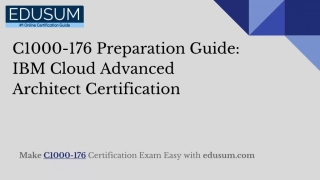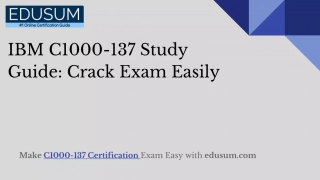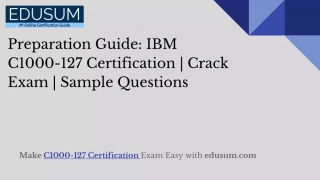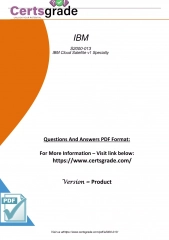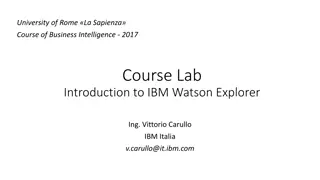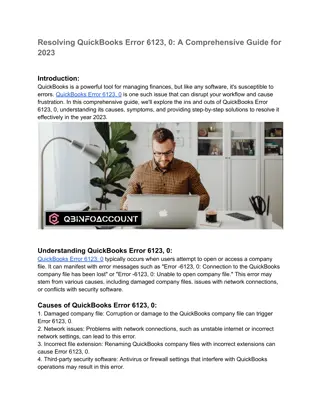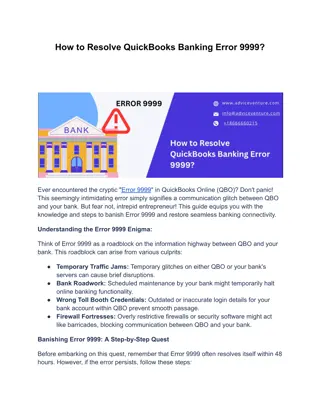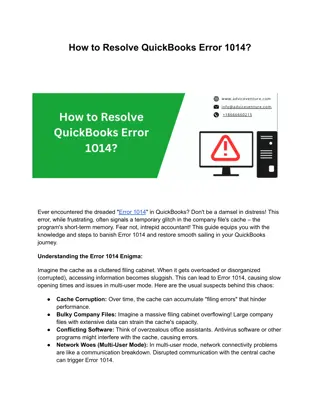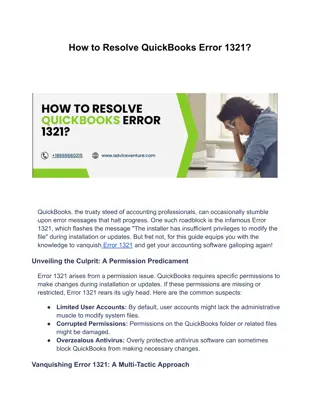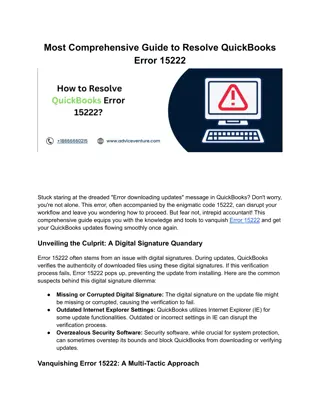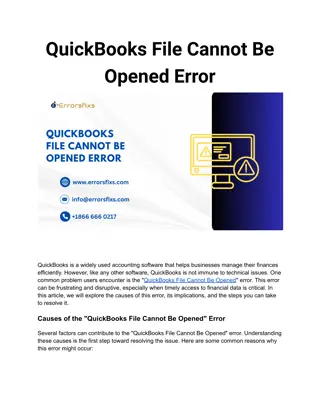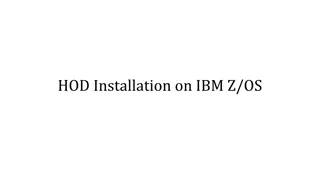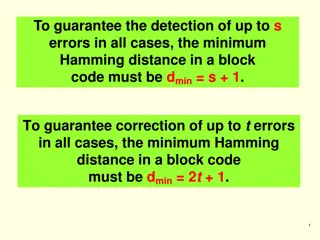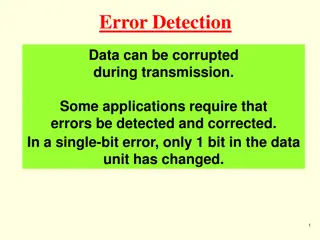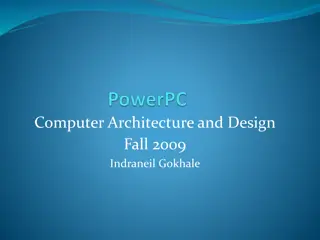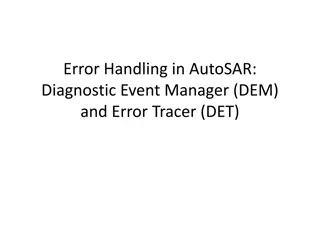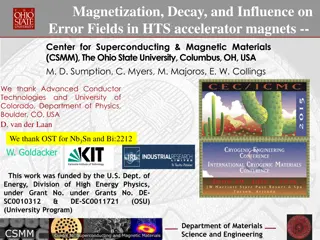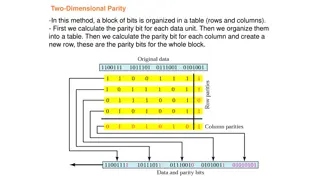Error Detection on IBM 5Q Chips
This paper explores the benefits of error detection and fault-tolerant design in quantum circuits using IBM 5Q chips. It discusses theoretical error rates, practical implications, and the effectiveness of error correction techniques in improving device performance.
Download Presentation

Please find below an Image/Link to download the presentation.
The content on the website is provided AS IS for your information and personal use only. It may not be sold, licensed, or shared on other websites without obtaining consent from the author.If you encounter any issues during the download, it is possible that the publisher has removed the file from their server.
You are allowed to download the files provided on this website for personal or commercial use, subject to the condition that they are used lawfully. All files are the property of their respective owners.
The content on the website is provided AS IS for your information and personal use only. It may not be sold, licensed, or shared on other websites without obtaining consent from the author.
E N D
Presentation Transcript
IS ERROR DETECTION HELPFUL ON IBM 5Q CHIPS ? CHRISTOPHE VUILLOT 1 - JARA Institute for Quantum Information, RWTH Aachen University Physikzentrum Campus Melaten Otto-Blumenthal- Strasse, 52074 Aachen, Germany 2 - QuTech, TU Delft Lorentzweg 1, 2628 CJ Delft, Netherlands Slides by: Anushka Gupta
Motivation: The main goal of this paper was to show evidence for the advantage of using error detection and fault-tolerant design of quantum circuits realized on IBM 5Q chips. A variety of devices which are built to aim at implementing reliable qubits have notable errors present due to their very own nature. There are some threshold theorems and techniques that prove theoretically that there exists error rates below which these approaches can improve the device performance. But the practicality is not yet clear. Using IBM 5Q chips to show that error detection can improve some simple sampling tasks ,the author thus tries to clear a tiny portion of fog on the technical details and the practicality of error detection.
Continued.. Some papers show experiments based on the same error detecting code, on trapped-ion qubits and on a similar superconducting chip, respectively. Both those works focus on the preparation of few states and only one of the two encoded qubits is handled fault- tolerantly. Devising, proving and simulating fault-tolerant schemes has been pursued for the last 20 years, but improving and finding better schemes is still important and a subject of ongoing research. In this work an extensive set of fault-tolerant circuits is studied and both logical qubits are protected.
General Approach Idea: 1. 2. Choose a Quantum Error Correcting Code C . Admit Fault-tolerant (FT) circuits for preparation of logical states |s1 ,...,|sm SFCT. As well as for some logical quantum gates, denoted as U1,...,Un GCFT . Using these as building blocks one can then randomly draw a state preparation from SFCT, then draw a sequence of gates from GCFT to obtain an encoded fault-tolerant circuit. Following the formalism of rectangles and extended rectangle ,one interleaves the logical units (gates in GCFT, or preparation of states in SFCT) with a fault-tolerant circuit for error correction. 3. 4. 5.
Rectangles designate circuits comprising one logical unit preceded by a round of error correction. Extended rectangles designate circuits comprising one logical unit preceded and followed by a round of error correction.
The precise conditions to satisfy in order to be fault-tolerant for distance 3 codes are stated as: 1. If a 1-EC contains no fault, it takes any input to an output in the code space. 2. If a 1-EC contains no fault, it takes an input with at most one error to an output with no errors. 3. If a 1-EC contains at most one fault, it takes an input with no errors to an output with at most one error. 4. If a 1-Ga contains no fault, it takes an input with at most one error to an output with at most one error in each output block. 5. If a 1-Ga contains at most one fault, it takes an input with no errors to an output with at most one error in each output block.
IBM 5Q chip and the [[4,2,2]] Code In 2016 IBM released a quantum chip with fixed-frequency superconducting transmon qubits, named IBM 5Q. They provide worldwide cloud access to the chip under an initiative called the IBM Quantum Experience The chip has five qubits, natively named q0 to q4. It features single qubit Clifford gates, the T gate (diag(1,ei /4)) as well as some two- qubits CNOTs with a certain layout represented in Fig. (a). These many qubits are the right number to use for a demonstration using the [[4, 2, 2]] code.
The [[4, 2, 2]] code encodes two qubits into four physical qubits. Its code space is stabilized by the all-X and all-Z Pauli operators (SX =X X X X , SZ=Z Z Z Z), together with the logical Pauli operators. The logical code states are :
The code also admits transversal implementations of two Clifford gates, namely H H SWAP, where H is the Hadamard gate, see Fig. 2a, and the controlled phase or CZ gate, see Fig. 2b. Moreover, if the five qubits have the right connectivity then there are fault-tolerant circuits preparing the logical states |00 L, |0+ L and |00 L + |11 L .
For the cat state |00L , see Equation (1), there exists fault- tolerant preparations (as in figures below) including one qubit to verify the preparation. Since the FTv1 is more appropriate to the layout all the results are obtained from it.
Also created a short 3 CNOT version which is non fault tolerant as below: And the implementation of swap gate:
For the preparation of |0+L , we want to create a Bell pair between q1 and q3 and between q2 and q4. There is a missing connection between q1 and q3, so we use SWAP as in Fig.6a. The preparation for |00 L + |11 L can itself be straightforwardly implemented fault-tolerantly, see Fig. 6b.
To summarize, our sets of initial states and gates are: SFT={|00 , |0+ , 1/ 2 (|00 + |11 )} GFT = {X1 ,X2 ,Z1 ,Z2 ,H H SWAP ,CZ}. The [[4,2,2]] code is only an error detecting code and so in place of error correction we have to rely on post- selection to remove errors. We throw away runs where an error has occurred, either from the ancilla measurement checking state preparation, or from the final measurement which indicates, when the parity of the outcomes is odd, that SZ has value 1.
One can obtain 20 different stabilizer states, with their most efficient bare preparation circuit, using the native set of gates provided by IBM, as in Figure 7.
Performance Metric For each circuit run we want to compare the observed outcome distribution with the ideal one. The ideal distribution is 8192 independent samples from a distribution with four possible outcomes occurring with probabilities p00, p01, p10 and p11. Since we assume that the conditions stay identical during one run and that the 8192 shots are independent, we observe independent samples from a four-outcome distribution with some different probabilities p 00, p 01, p 10 and p 11.
Comparisons We first need to decide on what pair of bare qubits is the best to be compared to the encoded qubits. It is not immediately clear how to choose this given only the calibration numbers. Thus we tried out the six different connected pairs and we found the performance shown in Figure 8.
Comparing the encoded versions of the circuits to the elected best pair in Figure 9.
We dont have a systematic method for predicting the best pair given the calibration data and the circuit, we will look at average performance for each pair over all the circuits. When averaging, we find the pair [2 0] to be the best also preparation for |00 L ,one can see that FTv1 is better than the best bare implementation whereas NFT is worse.
Appendix For each run, IBM also provides calibration data describing the state of the chip such as: gate error rates, readout error rates, T1, T2 and fridge temperature.
The two chips are similar, the gate and readout error rates have been slightly improved with Raven but the fridge temperature as well as T1 and T2 times became a bit worse.
Possible Future Work We have shown that already on the IBM 5Q chip one can improve some quantum computation task, namely sampling from a class of states, by using error detection and fault-tolerant design of circuits. As better and better hardware is developed, with more physical qubits, more connectivity and smaller error rates, demonstrations of fault-tolerance will become easier to produce and become more convincing. For the [[4, 2, 2]] code a few more qubits and connections would be needed to realize fully fault-tolerant circuits with error detection in between logical units. Being able to demonstrate the fault-tolerance of larger gate sets, for example the whole Clifford group for several logical qubits would be an important milestone towards harnessing universal Quantum computation. circuits.


